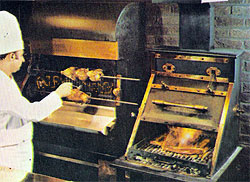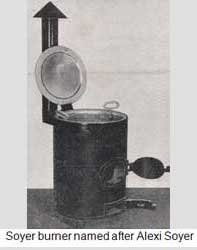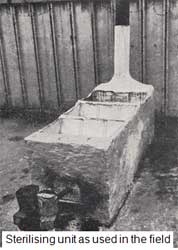| Large Kitchen Equipment – Small Hand Tools – Menus and Books – Service Gear – Moulds – Copperware – Cutters – Canvas Art1 – Canvas Art2 – Decorative Tools – Paraphernalia. | ||||
| Catering and Hotel Keeper – Fuller – 1950 – 1980 – Used to grill steaks and grill poultry on a charcoal grill when orders were barked. Imagine how hot this was? I know I worked on one | ||||
 |
||||
| Soyer Burner – Contributor: Jock Stewart- NSW – 1856-1982. In the Crimean War Alexis Soyer helped Florence Nightingale look after the wounded. Her nursing would have been of little use if the recovering soldiers were not properly fed. Along the way he invented the first cooker adopted by the British Army, the Soyer Field Stove. The stove remained an essential part of the standard kitchen equipment through both World Wars and all campaigns until the Falklands War in 1982, when, an Exocet missile hit the massive supply vessel Atlantic Conveyor. Although the ship went down with Chinook helicopters, tragically it was the fact that the bulk of the army’s stock of Soyer stoves was lost that caused a lot of concern. The Soyer stoves were used by many organisations during World War II and were staffed by the Women’s Voluntary Service who provided emergency food in the bombed areas during the Blitz. The stove was capable of boiling 12 gallons ( liters) of liquid using any available solid fuel. They were simple and efficient. The original specification was that two stoves, together with wood for fuel, could be carried by a mule. There were 20 stoves to a regiment, allowing 300 lbs. ( kg) of meat to be cooked per thousand men. Coal will burn with the same advantage as wood. They could also be fitted with an apparatus for baking, roasting, and steaming. By the removal of the caldron, and the application of a false bottom put over the fire, the stove could be used for baking bread as well as roasting meat, potatoes, puddings etc.This was the most ingenious piece of field equipment that British army cooks ever used. | ||||
 |
||||
| Sterilising unit used in field Contributor: Jock Stewart- NSW 1940 – 1972. This unit would only be used in areas where cooks were feeding a company of 125 or more men for a considerable length of time. One of the advantages of this unit was that the water could remain heated whilst in use. This unit comprised of 3 x 44 gallon drums cut in half lengthwise with handles attached at either end for easy carrying. One held water for washing, one for rinsing and the other for sterilizing. A quantity of bricks and mud or cement were used to form the base of the apparatus.Two sheets of galvanized metal were used to support the roof of the fire box and chimney at the end of the unit. Old 7lb.biscuit tin were used to make the chimney. Water in the troughs was heated by using any heating materials available. This was a good way of disposing of any food scraps, but more often than not they were kept hot by using a No. 1 burner which stood on a securely raised base. The flame travelled along the length of the unit, under the three drums before entering the chimney. To empty the drums the water was partly bailed out before they were lifted by using the handles and drained. | ||||
 |
||||
.